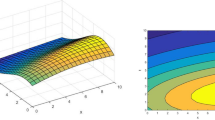Abstract
We have found hundreds of solutions to the integrability equations in aesthetic field theory. The behavior of the solutions to the aesthetic field equations depends on which solution to the integrability equations we take. From computer runs down a coordinate axis we have found a type of solution where we have a maximum and a minimum, as well as the field going to zero at large distances along both directions. This kind of solution is quite prevalent. We call this type of solution a “pulse” solution. We have found the “pulse” solution in two and three dimensions as well as four dimensions. It appears regardless of whether certain symmetries are present or absent. We have taken a two- or three-dimensional Г β α γ and made a four-dimensional theory from it with the use of a four-dimensionale α i. This process we call “imbedding.” We have found imbedding has not affected the overall characteristics of the solution in the cases we considered. We were able to change the character of the solutions to some degree by altering the magnitude of some of the gammas—but this did not lead to solutions with significantly more wiggles. We also found an example of an oscillatory solution. The oscillations occurred in too regular a pattern to give a realistic model for basic behavior. However, this solution indicates that aesthetic field theory has more structure then we have ever seen before. We also obtained a solution in which errors took over so fast that the computer was literally helpless in telling us what is going on. In other solutions the field appears to increase without bounds. Whether this is due to singularities or to the presence of large numbers is not clear.
Similar content being viewed by others
References
Eddington, A. (1960).Mathematical Theory of Relativity, p. 149 Cambridge Press, Cambridge.
Muraskin, M. (1974).International Journal of Theoretical Physics,9, 405.
Muraskin, M. (1975).International Journal of Theoretical Physics,13, 303.
Muraskin, M., and Ring, B. (1974).International Journal of Theoretical Physics,11, 93.
Muraskin, M., and Ring, B. (1975a).Foundations of Physics,5, 513.
Muraskin, M., and Ring, B. (1975b).International Journal of Theoretical Physics,12, 157.
Muraskin, M., and Ring, B. (1976a).International Journal of Theoretical Physics,15, 521.
Muraskin, M., and Ring, B. (1976b).International Journal of Theoretical Physics,15, 513.
Muraskin, M., and Ring, B. (1977).Foundations of Physics,7, 451.
Author information
Authors and Affiliations
Rights and permissions
About this article
Cite this article
Muraskin, M. A study of solutions to the aesthetic field equations. Int J Theor Phys 18, 433–444 (1979). https://doi.org/10.1007/BF00670061
Received:
Issue Date:
DOI: https://doi.org/10.1007/BF00670061




